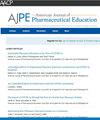在客观结构化临床检查(oses)中使用Goldilocks帮助解决问题的脚手架。
IF 3.5
4区 教育学
Q1 EDUCATION, SCIENTIFIC DISCIPLINES
引用次数: 0
摘要
目的:目的由于时间压力和焦虑,结构化临床考试(OSCEs)对学生来说可能是压倒性的。算法和框架可以通过将解决问题的过程分解为提示和步骤来帮助解决问题。方法:根据马来西亚和澳大利亚院校学生的表现等级(高、中、低),选择了60个评估数据。围绕Goldilocks帮助模型步骤构建的内容和主题分析被用来评估学生在解决欧安组织问题时发生的元认知过程。结果:来自所有表现水平的学生最初专注于了解患者病史和药物。中高水平的医生有效地利用医疗资源进行安全检查和决策,而低水平的医生则难以识别与药物相关的问题,反映出知识应用方面的差距。“金发女孩”模式的每个步骤的重点在不同的科室有所不同,所有学生都优先考虑最初的患者信息收集,但根据他们的知识水平,他们分析和计划干预措施的能力有所不同。结论:本研究提供证据表明,药学专业学生的自然问题解决过程,如欧安组织后反思所述,遵循欧安组织期间的五个金凤花帮助步骤。表现不佳的学生在第二步(分析)上挣扎,在第三步(计划)上花了太多时间。教育工作者可以使用Goldilocks帮助来支持表现不佳的学生,通过更系统的方式指导他们的思维过程,直到他们能够建立自己的专业知识,以更灵活的方式解决问题。本文章由计算机程序翻译,如有差异,请以英文原文为准。
Scaffolding for Problem Solving Using Goldilocks Help in Objective Structured Clinical Examinations
Objective
Objective Structured Clinical Examinations (OSCEs) can be overwhelming for students due to time constraints and anxiety. Algorithms and scaffolds can assist with problem solving by breaking the process into prompts and steps.
Methods
In total, 60 assessment data points based on performance tier (high, middle, and low) from students across Malaysian and Australian institutions were selected. Content and thematic analyses, structured around the Goldilocks Help model steps, were employed to assess students' metacognitive processes that occur during OSCE problem solving.
Results
Students from all performance levels initially focused on understanding patient history and medications. Top and middle performers effectively used medical resources for safety checks and decision-making, while lower performers struggled with identifying medication-related problems, reflecting gaps in knowledge application. Emphasis on each step of the Goldilocks model varied across stations. All students prioritized initial patient information gathering, but their ability to analyze and plan interventions differed according to their knowledge level.
Conclusion
This study provides evidence that student pharmacists’ natural problem-solving process, as described in post-OSCE reflections, follows through the 5 Goldilocks Help steps during OSCEs. Low performing students struggled with step 2 (Analyze) and spent excessive time on step 3 (Plan). Educators can use Goldilocks Help to support low performing students by guiding their thought processes through a more systematic way until they are able to build their expertise to approach problems in a more flexible manner.
求助全文
通过发布文献求助,成功后即可免费获取论文全文。
去求助
来源期刊
CiteScore
4.30
自引率
15.20%
发文量
114
期刊介绍:
The Journal accepts unsolicited manuscripts that have not been published and are not under consideration for publication elsewhere. The Journal only considers material related to pharmaceutical education for publication. Authors must prepare manuscripts to conform to the Journal style (Author Instructions). All manuscripts are subject to peer review and approval by the editor prior to acceptance for publication. Reviewers are assigned by the editor with the advice of the editorial board as needed. Manuscripts are submitted and processed online (Submit a Manuscript) using Editorial Manager, an online manuscript tracking system that facilitates communication between the editorial office, editor, associate editors, reviewers, and authors.
After a manuscript is accepted, it is scheduled for publication in an upcoming issue of the Journal. All manuscripts are formatted and copyedited, and returned to the author for review and approval of the changes. Approximately 2 weeks prior to publication, the author receives an electronic proof of the article for final review and approval. Authors are not assessed page charges for publication.

 求助内容:
求助内容: 应助结果提醒方式:
应助结果提醒方式:


